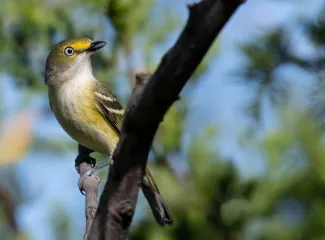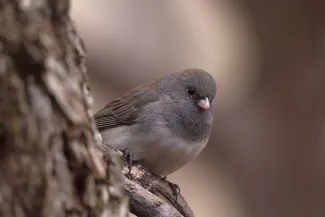Oklahoma’s Wildlife Management Areas have long been considered great places to bag a turkey or shoot a limit of quail or teal. But they’re also great places to spot migrating warblers as they parade high in the treetops, listen to a symphony of songbirds, and watch raptors as they patrol the open prairies.
The Wildlife Department manages habitat on more than 1.4 million acres to provide birds and other wildlife places to live, and places for sportsmen, sportswomen, and outdoor enthusiasts such as bird watchers to enjoy Oklahoma’s natural world. Find trip-planning resources like maps and contact information for the Wildlife Department-managed areas and lakes at wildlifedepartment.com. Regulations and specific license or Conservation Passport requirements for individual WMAs also can be found in the free Oklahoma Hunting and Fishing Regulations Guide, available online or where licenses are sold.
Regardless of the location or season of your visit, a field guide, binoculars or spotting scope, camera, water, and snack bag can make any bird watching or nature trip more enjoyable.
Be Wowed by Warblers in the Spring

Yellow-throated warbler.
Full of energy, warblers burst into Oklahoma’s forests each spring, luring many bird watchers to the woods with bright colors and sweet summoning calls. A number of the 42 warbler species documented in Oklahoma settle by and large in the eastern half of the state for the summer while others only land for a few short days or weeks on their journey to more northern breeding grounds.
In a seemingly constant search for insects, warblers jump from branch to branch high in the treetops or sift through mountains of leaves on the forest floor. Narrow your search to trees and shrubs near creeks and small rivers for the best warbler watching, or in areas with flowering trees that will attract a number of small insects. Warblers rarely offer long, full views of their colorful bodies, but identification often can be narrowed by facial color patterns or the amount and location of streaking or splashes of color on the body. Longtime chasers of warblers often suggest studying a field guide before any bird-watching trip and warn of neck cricks after long bouts of tree-top searching.
Many Wildlife Management Areas host warblers throughout the spring and summer. Prime warbler-watching areas include Cookson and Red Slough WMAs, and Blue River Public Fishing and Hunting Area.
Share Summer with Songbirds

White-eyed vireo.
Spring’s harmony of birdsong leads to nest building, frequent feeding sessions, and a summer filled with birds. More than 200 species of birds, from flycatchers and sparrows to nighthawks and vireos, raise their young within our state’s borders and offer months of bird-watching opportunities for Oklahoma’s residents.
An early start is the best way to kick off a summer bird watching trip since songbirds are most active with their nest chores and insect hunting during the cooler morning hours. Once a bird is spotted, narrow the possibilities to a few species by looking for simple clues like the size, contrasting colors, and bill shape. Other hints can come from the bird’s behavior and location of the bird, either in its habitat, or within the state.
Wildlife Management Areas across the state hold summering songbirds including Lexington, Atoka, Packsaddle, Sandy Sanders, and Spavinaw WMAs. Search along grassland fencerows for sparrows, shrikes and thrashers and along tree rows for wrens, chickadees, and tanagers.
Rejoice in Autumn Raptors

Northern harrier.
As summer gives way to fall, our birdlife also changes. Visiting songbirds pack their bags for the journey south, and we begin seeing many more hawks and owls patrolling fields and prairies. Oklahoma’s red-tailed hawk population blooms as birds from northern states join our resident population for the winter. And other raptors like northern harriers, short-eared owls, and bald eagles become more common in the state by mid-fall.
Hawk watching is often done from a vehicle, with frequent stops when a raptor comes into view. Birding partners are recommended to help spot perched and flying hawks along the way and to find safe pull-off areas. They can also help look for identification clues when a raptor is spotted. Size of the bird and shape of the wings and tail are good clues, as well as coloration, behaviors, and location.
Western Oklahoma’s prairies and shrublands are great spots to watch for hawks, but woodlands also offer raptor-watching opportunities. Try WMAs like Hackberry Flat, Beaver River, and Hulah for hawk-watching trips, and focus on the shorelines of WMAs surrounding lakes like Kaw, Eufaula, and Tenkiller for eagle watching.
Bundle Up for Winter Sparrows

Dark-eyed junco.
Birding opportunities can heat up in the winter as a suite of sparrows and their relatives settle in across the state. White-crowned, Savannah, and song sparrows are dependable finds, towhees regularly pop up in brambles, and the dark-eyed junco, the fourth most abundant land bird in North America, is a birder’s steady winter friend.
Winter birding can include brisk walks, slow drives down rural roads, or feeder watching from the comfort of your home. Because these birds are largely seed-eaters, they are regular visitors to backyard feeders, especially during cold or snowy periods.
Wildlife Management Areas across the state host winter sparrows, including Cimarron Hills, Deep Fork and Cross Timbers WMAs. Be sure to keep a close eye for birds foraging along the roadways or sheltering in brush piles and fallen trees.
Once your bird-watching trip is complete, consider sharing your sightings with online nature sharing platforms like eBird and iNaturalist. Both portals offer a way to not only share your trip with outer outdoor enthusiasts but may help guide your next trip.